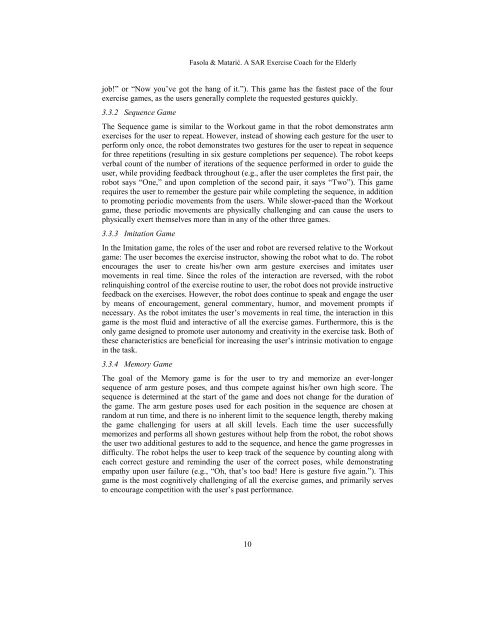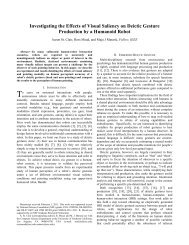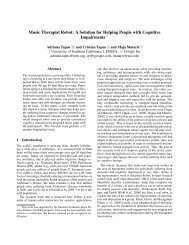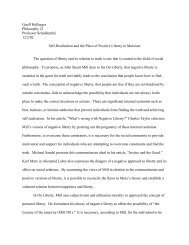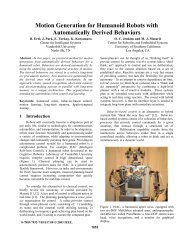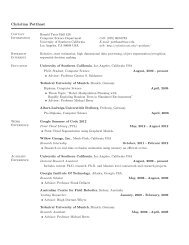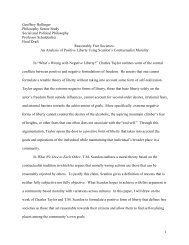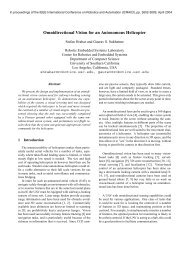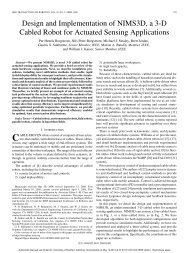A Socially Assistive Robot Exercise Coach for the Elderly
A Socially Assistive Robot Exercise Coach for the Elderly
A Socially Assistive Robot Exercise Coach for the Elderly
You also want an ePaper? Increase the reach of your titles
YUMPU automatically turns print PDFs into web optimized ePapers that Google loves.
Fasola & Matarić. A SAR <strong>Exercise</strong> <strong>Coach</strong> <strong>for</strong> <strong>the</strong> <strong>Elderly</strong>job!” or “Now you’ve got <strong>the</strong> hang of it.”). This game has <strong>the</strong> fastest pace of <strong>the</strong> fourexercise games, as <strong>the</strong> users generally complete <strong>the</strong> requested gestures quickly.3.3.2 Sequence GameThe Sequence game is similar to <strong>the</strong> Workout game in that <strong>the</strong> robot demonstrates armexercises <strong>for</strong> <strong>the</strong> user to repeat. However, instead of showing each gesture <strong>for</strong> <strong>the</strong> user toper<strong>for</strong>m only once, <strong>the</strong> robot demonstrates two gestures <strong>for</strong> <strong>the</strong> user to repeat in sequence<strong>for</strong> three repetitions (resulting in six gesture completions per sequence). The robot keepsverbal count of <strong>the</strong> number of iterations of <strong>the</strong> sequence per<strong>for</strong>med in order to guide <strong>the</strong>user, while providing feedback throughout (e.g., after <strong>the</strong> user completes <strong>the</strong> first pair, <strong>the</strong>robot says “One,” and upon completion of <strong>the</strong> second pair, it says “Two”). This gamerequires <strong>the</strong> user to remember <strong>the</strong> gesture pair while completing <strong>the</strong> sequence, in additionto promoting periodic movements from <strong>the</strong> users. While slower-paced than <strong>the</strong> Workoutgame, <strong>the</strong>se periodic movements are physically challenging and can cause <strong>the</strong> users tophysically exert <strong>the</strong>mselves more than in any of <strong>the</strong> o<strong>the</strong>r three games.3.3.3 Imitation GameIn <strong>the</strong> Imitation game, <strong>the</strong> roles of <strong>the</strong> user and robot are reversed relative to <strong>the</strong> Workoutgame: The user becomes <strong>the</strong> exercise instructor, showing <strong>the</strong> robot what to do. The robotencourages <strong>the</strong> user to create his/her own arm gesture exercises and imitates usermovements in real time. Since <strong>the</strong> roles of <strong>the</strong> interaction are reversed, with <strong>the</strong> robotrelinquishing control of <strong>the</strong> exercise routine to user, <strong>the</strong> robot does not provide instructivefeedback on <strong>the</strong> exercises. However, <strong>the</strong> robot does continue to speak and engage <strong>the</strong> userby means of encouragement, general commentary, humor, and movement prompts ifnecessary. As <strong>the</strong> robot imitates <strong>the</strong> user’s movements in real time, <strong>the</strong> interaction in thisgame is <strong>the</strong> most fluid and interactive of all <strong>the</strong> exercise games. Fur<strong>the</strong>rmore, this is <strong>the</strong>only game designed to promote user autonomy and creativity in <strong>the</strong> exercise task. Both of<strong>the</strong>se characteristics are beneficial <strong>for</strong> increasing <strong>the</strong> user’s intrinsic motivation to engagein <strong>the</strong> task.3.3.4 Memory GameThe goal of <strong>the</strong> Memory game is <strong>for</strong> <strong>the</strong> user to try and memorize an ever-longersequence of arm gesture poses, and thus compete against his/her own high score. Thesequence is determined at <strong>the</strong> start of <strong>the</strong> game and does not change <strong>for</strong> <strong>the</strong> duration of<strong>the</strong> game. The arm gesture poses used <strong>for</strong> each position in <strong>the</strong> sequence are chosen atrandom at run time, and <strong>the</strong>re is no inherent limit to <strong>the</strong> sequence length, <strong>the</strong>reby making<strong>the</strong> game challenging <strong>for</strong> users at all skill levels. Each time <strong>the</strong> user successfullymemorizes and per<strong>for</strong>ms all shown gestures without help from <strong>the</strong> robot, <strong>the</strong> robot shows<strong>the</strong> user two additional gestures to add to <strong>the</strong> sequence, and hence <strong>the</strong> game progresses indifficulty. The robot helps <strong>the</strong> user to keep track of <strong>the</strong> sequence by counting along wi<strong>the</strong>ach correct gesture and reminding <strong>the</strong> user of <strong>the</strong> correct poses, while demonstratingempathy upon user failure (e.g., “Oh, that’s too bad! Here is gesture five again.”). Thisgame is <strong>the</strong> most cognitively challenging of all <strong>the</strong> exercise games, and primarily servesto encourage competition with <strong>the</strong> user’s past per<strong>for</strong>mance.10


